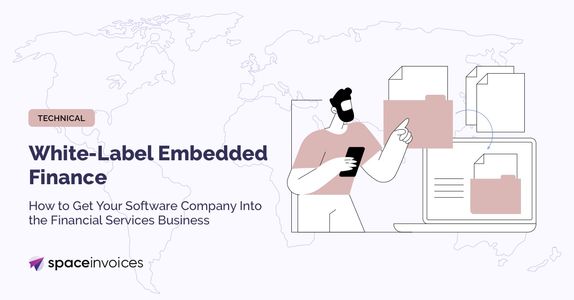White-Labeled Embedded Finance: How to Get Your Software Company Into the Financial Services Business
If you've wondered how your software business can be extended with additional financial services that you can offer to your customers and clients, we’ve prepared this guide as a way to get you started on this path to greater revenue and increased company value.
What is Embedded Finance?
No longer confined to traditional financial institutions or fintech startups, digital financial services can now be offered by any SaaS platform, regardless of their industry focus. Embedded finance, at its core, is the ability for any SaaS platform to offer branded financial services within their platform. Consider for example how e-commerce giants allow for direct financing or how social media platforms have introduced peer-to-peer lending and money transfers. These are everyday examples of embedded finance in action. It offers a dual advantage: platforms can enhance user experience, create new revenue streams, increase customer engagement, and ultimately increase shareholder value.
The Role of White-Labeling
White-labeling, in the simplest terms, is taking a generic product and branding it as a company's own. In the world of finance, white-labeling involves integrating established, third-party financial solutions into a one company or platform, and then branding them to their new customers, as native banking services. For software companies, for example, this means they can offer customers complex financial services without the monumental task of creating them. It's efficient, cost-effective, and significantly lowers developmental risks.

Embedded Finance Use Case - Invoicing:
Every company needs to invoice their customers, so why shouldn’t all B2B SaaS companies offer invoicing services as part of their core solution. While it’s true that they could “hand off” the invoicing function to 3rd party accounting platforms, such as Quickbooks, the problem is that these integrations are clumsy and the brand of the company gets lost in the transaction. By using an API to offer white-label invoicing services, a B2B SaaS company gets the benefit of stronger branding, deeper customer engagement, and also new revenue streams.
Embedded Finance Use Case - Payments:
If you offer invoicing as a service on your SaaS platform, the natural next step is to also offer integrated payments. There are companies that have led the charge in these services, such as Stripe. To their credit, they have made it common for SaaS companies to offer payment solutions to their customers. The great news for SaaS companies is that there are now dozens of highly innovative payment processing platforms on the market, and they are now helping to reduce the fees involved. GetPaid is one example of such a payments solution provider that can also offer invoicing services through its partner, Space Invoices.

Why Every Software Company Should Consider White-Labeled Embedded Finance
Instant Implementation:
Developing financial solutions from scratch is time-consuming. White-label digital payment solutions are like plug-and-play business models, significantly cutting down the go-to-market time.
Enhanced User Engagement:
The modern user values convenience. By offering more access to integrated financial solutions, platforms can significantly enhance user convenience, leading to more purchases and longer and more engaging user sessions.
Diversified Revenue Streams:
With embedded finance, revenue isn't just about subscriptions or sales. Companies can earn from transaction fees, financial product commissions, and even interest from capital and funds and credit solutions funds.

A Step-By-Step Guide to Venturing into White-Labeled Embedded Finance
Deep Dive into Market Research:
Before taking the plunge, understand your audience. What are their financial needs? Do they need access to payment or debit cards, bank account gateways, insurance options, credit solutions, or investment avenues? An aligned solution is always more successful.
Start with Invoicing and Payments:
While there are many different embedded finance applications, many can get pretty complex, especially when they involve complex credit terms, cross-border taxation, and other forms of lending. In most cases, the simplest and lowest-risk places to start are in invoicing and payments.
The Perfect Partner:
The first white label software service provider you choose will be pivotal. Consider their track record, the scalability of solutions, flexibility, etc. If you start with invoicing and payments, find a partner who can offer these as an integrated solution. Space Invoices and GetPaid are two companies that can offer such an integrated solution.
Use APIs:
In the early days of embedded financial services, the integrations of systems and functionality were complex and costly. Today, the best solutions on the market are accessible through simple, well-documented APIs. Consider the quality of the API, the clarity of the documentation, and the ability to have you up and running in just a few days. These are indicators of the right companies to work with on embedded financial solutions, especially those that will best represent your brand.
Seamless Integration:
This is where the tech team comes in. Through APIs, integrate and scale the financial solution within your platform. The goal should be a seamless customer experience here, where the user doesn't feel jolted by the new addition of financial services.
Branding Matters:
The integrated solution should feel organic. Customize its appearance, workflows, tools and user journeys to mirror your brand's ethos and aesthetics.
Launch, Support, Iterate:
Once you roll out the new services, be ready for teething issues. Support is crucial. Gather feedback, understand pain points, and iterate to improve continuously.

Anticipating and Overcoming Hurdles
White-labeled embedded finance is promising, but it isn’t a walk in the park:
Regulatory Labyrinth:
Financial services come with a maze of regulations. While your white-label banking partner will handle the bulk of it, customers being informed is crucial. It's also imperative to ensure that the banking platform stays compliant as regulations evolve.
Fortifying Data Security:
Finances translate to sensitive data. Employ state-of-the-art encryption, conduct regular security audits of third parties' funds and operations, and ensure that the third-party solution adheres to global security standards.
User Adaptation:
Change, even if positive, can be overwhelming. Provide comprehensive resources — tutorials, FAQ sections, webinars, and dedicated support channels — to guide your users.

The Potential and Promises: Real-World Success Stories of Embedded Finance
Embedded finance, especially in its white-labeled banking form, isn't just a theoretical advantage for banks; it's a proven success model for businesses. Delving into a few real-world examples can elucidate the tangible business benefits to customers, employees and market scope of this amalgamation:
Ride-Sharing Platforms:
Giants like Uber and Lyft have redefined transportation, but their financial innovations are equally commendable. Uber, for instance, introduced Uber Cash – a digital wallet that offers bonuses for user deposits, purchases and pay down. This not only simplifies payments for customers but binds the user further into the platform's ecosystem.
E-Commerce Sites:
Platforms like Amazon and Shopify have incorporated lending solutions. Amazon Lending, a short-term loan service, helps sellers access capital to finance their inventory. This is a win-win as it ensures a constant product supply and demand for Amazon while aiding sellers in scaling up their operations.
Tech Companies Offering Financial Management:
Companies like Intuit, known for QuickBooks, expanded their offerings with embedded financial services. By integrating processes for business expenses like invoice financing and business loans, they've transformed from being software solutions to holistic business platforms.
Social Media Forays into Finance:
WeChat in China exemplifies this fusion. Initially a messaging app, it has morphed into a financial hub, offering services like payments, money transfers, banking, and even insurance.
These three bank success stories underline a simple truth about banking: consumers appreciate the seamless integration of banking and financial services in platforms and tools they frequently use. It streamlines their tasks of banking and transactions, offers them convenience, and often provides them access to financial benefits like discounts or rewards.
For software companies, these examples offer not just inspiration but also a blueprint. The potential for growth, user retention, customer name, brand name, and revenue multiplication is undeniable. With the right strategy, partnerships, and execution, there's no reason why any software company can't replicate or even surpass these success stories.

Conclusion:
The intersection of finance and software development is bustling with opportunities. For software companies that aim to have employees create and stay ahead of the curve, white-labeled embedded finance can be a transformative business strategy. It not only promises enhanced user experiences for clients and employees but also opens doors to new revenue streams, previously deemed inaccessible for tech companies.
In a world where innovation is the key to many businesses' survival, embedding finance within your software platform might just be the next big leap. The future of business is integrated; it's time for businesses to embrace and manage it holistically.
Additional reading:
Start issuing Invoices, free!
Signup and start issuing compliant invoices from your software in minutes.
Or contact us to get a free implementation consultation.
